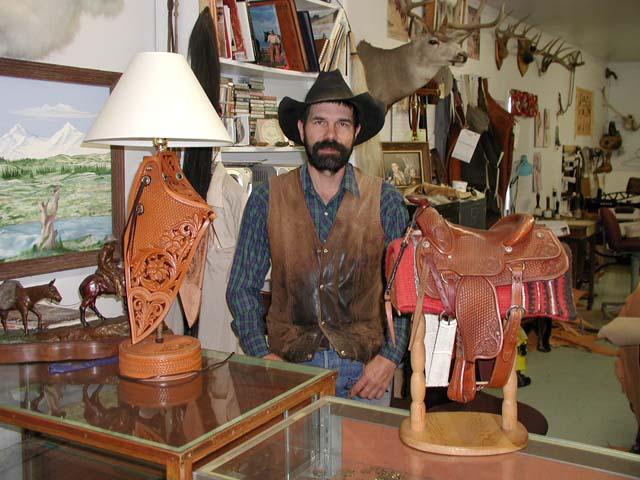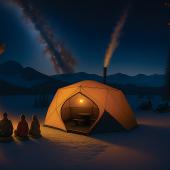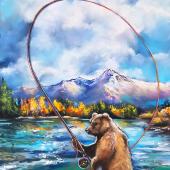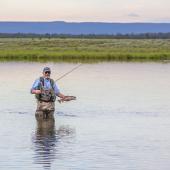Saddle Up
Wes Schenk's working art.
If you’re the type who judges a book by its cover, and therefore a shop by its exterior, you might miss out on one of the greatest living stories of the Old West. The blandly named Schenk’s Shoe and Saddle is housed in a bright blue warehouse on the outskirts of Harlowton, a small town about 40 miles north of Big Timber. Along with dozens of old-fashioned-looking machines scattered around the large main workroom and design studio, an old lever-action rifle and boots awaiting repair line a center table. Shiny pieces of metal of various sizes hang on the walls: a shimmering array of buckles and conchos waiting to become part of a working work of art. It is a quiet place, and the owner an unassuming man who affably assists everyone who enters his workshop. Wes Schenk works steadily at creating saddles by hand for those who will actually use them, and business has never been better.
Selling Western wear in Montana is not a unique enterprise. Every hamlet in the state has its own “authentic” Western outfitting store, and leather goods abound for all of your decorating needs. What sets Wes Schenk’s work apart is the time, attention, and skill he places into every piece. All of them are unique, and of his roughly 200 saddles to date, he admits to no favorite, because he learns something from each one. “It’s a good thing they’re all different,” he says, “because otherwise I’d get bored.” Each saddle takes Wes two to three weeks to complete, and he’s never working on just one project at a time. Boot repair, chaps, holsters—anything important to a cowboy can be either made or fixed here.
After being inspired by a high school leather-working class, Wes knew what he was born to do, eventually becoming so busy and popular that he had to move his store off Main Street and onto a quiet gravel road east of town. After 23 years downtown, “it got to the point, with so many people walking in and out, showing them around—I wasn’t getting any work done.” And he certainly has quite a bit to do. If you decide a Schenk saddle would be the perfect gift for that certain cowgirl in your life, don’t expect your wooing to come to fruition anytime soon—Wes’s waiting list is full until February of 2009.
Schenk’s Saddle and Shoes doesn’t advertise; instead, he relies on word of mouth to keep his clientele list growing. His praise is spread by such varied customers as actor Ed Harris, who has been by for a pair of custom-made chaps, and longtime neighbor John Spizziri, who firmly believes that Wes is “twice the saddle maker Charles Weldon is.” (Weldon, for those of us not in the know, is the saddler to the stars.) But Wes’s saddles are made for riding, and he wants them to be worked as hard as he’s worked on them. “My ideal customer is a working cowboy,” Wes explains. “I put a lot of time and effort into these saddles… I don’t go in for museum pieces.” In true cowboy fashion, Wes delivers an all-American product, ordering his tanned leather from a provider in St. Louis, which results in both higher quality and a heftier price tag. His clients know this, appreciate it, and show their satisfaction by coming back for more—50 percent of Wes’s business is for repeat customers.
Although much of his time is spent at the “office,” Wes is able to combine business with pleasure by joining his two sons, Will and Clay, in ranch roping events. For the past five or six years, the family affair has been roving the state together, working as a team, and scouting out potential clients. More likely, though, he’s encountering old ones. Wes recalls one ranch roping event in Big Timber composed of about 30 teams where, after the exhibition of skill and talent was over, the cowboys took their saddles off their horses and set them up on a fence railing. After an impromptu count, 19 were revealed to have been made by Schenk.
Wes earns these loyal cowboys’ trust through painstaking work and by handcrafting every detail. Recently Wes branched out of his leather design to attend a class in Colorado on etching the metal accents that adorn his custom saddles. For the most recent saddle, his client desired an Aztec design to border all of the pieces, an idea the Texas patron got from a book showcasing an early saddle popular in Montana in the 1870s. Wes was able not only to stamp the square snake design on the leather, but also etch it onto the small brass conchos that hold the leather straps, making the patterns a perfect match.
If you aren’t sure Aztec designs are for you, not to worry—Wes has a look-book of hundreds of designs so you’re sure to find something perfect for your personal saddle. For his out-of-state clients, Wes tools samples of different designs and sizes onto small pieces of leather to mail back and forth until they are just right. Whether it’s wild or tame roses, chaps or a gun holster, these unique works are masterpieces of Western art. Just remember that in addition to taking this artwork out of the museum, you can ride it into the ground.
For more information and pricing, contact Wes at 406-632-5893.
Saddle History
A couple millennia ago, a group of rovers known as the Sarmations started using saddles to aid in their looting, and the idea caught on. While the first saddles were little more than bunched-up blankets, by the middle ages saddles were not only a useful way to stay on a horse but also a way men could show off their artistic side while still pummeling each other to death. The rise of the cowboy meant a greater demand for working saddles, and the answer came in thousands of machine-made seats, and before 20 years ago, saddlery was a dying art. On one hand, manufactured saddles were cheaper and more readily available, and on the other, saddlery used to be a very secretive process. When visiting Wes’s shop, he’ll be glad to show you the intricate detailing and the numerous tools he works with; his artistic ancestors jealously guarded their trade and only took on one or two apprentices to teach, and some secrets of the trade died with them. It is thought that all of this mystery occurred because so many saddle-makers were famous in their circles, and to steal another’s trademark was tantamount to plagiarizing. These days, the art of saddle-making is experiencing a revival, and interest is welcomed and encouraged. Classes in leather tooling abound, trade fairs exist to share the wealth of knowledge, and the creation of these ancient seats has even permeated the Internet. For more information on cracking the secrets of western saddle making, see bcheaneysaddles.com, loonfeatherleather.com, and saddlemakers.org.











